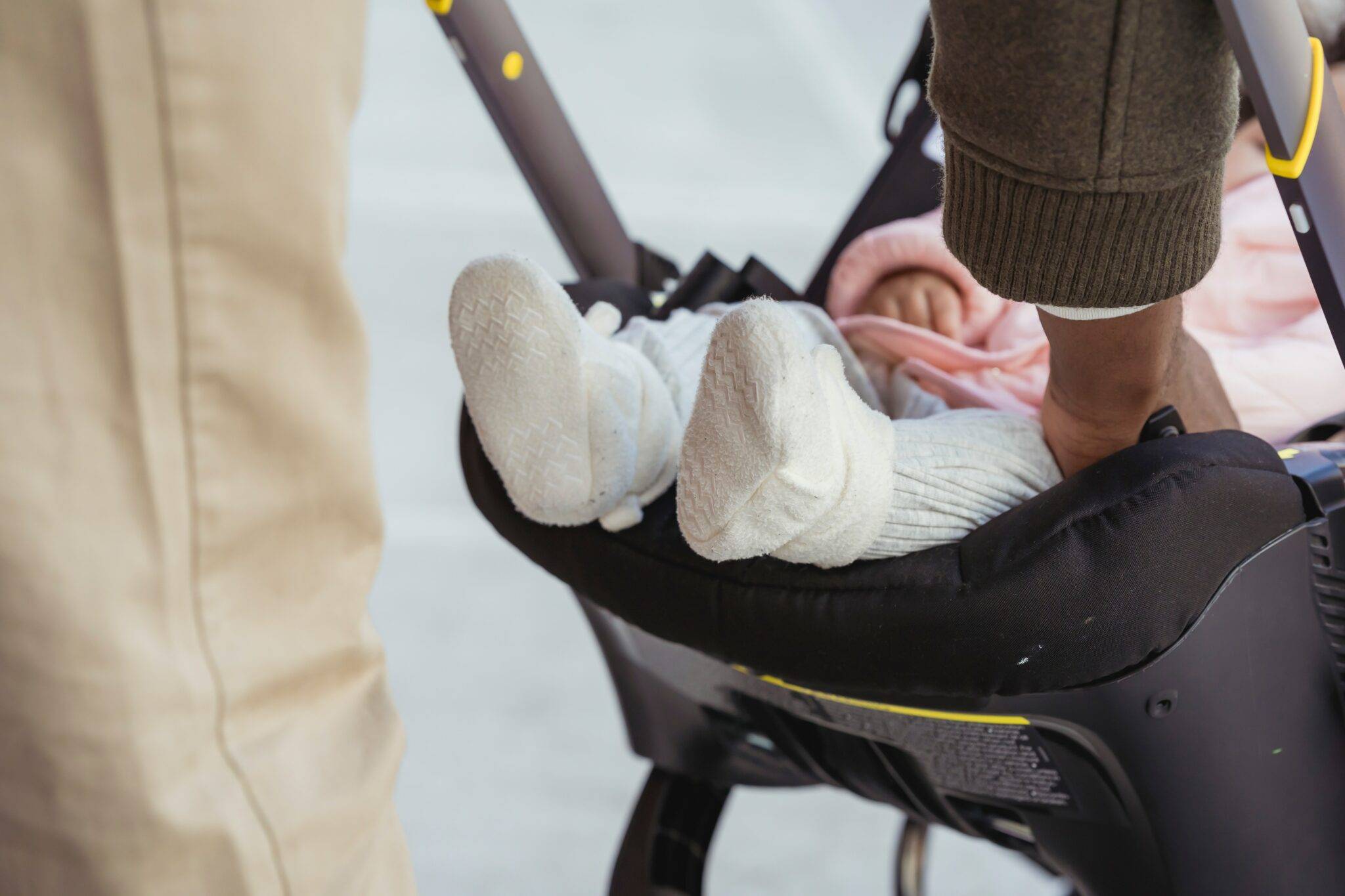Bringing a newborn into the world is a momentous occasion, filled with joy, love, and many questions. As a new parent, you constantly look for signs that your baby is developing normally. One of the questions that might pop up early on is whether it’s normal for your newborn baby roll onto their side.
The simple answer is yes, it can be normal, but like many aspects of newborn development, there’s more to consider. This blog post will dive deep into this topic, exploring what it means when your newborn starts rolling, when you can expect it to happen, and to ensure your baby stays safe throughout their developmental journey.
Understanding Newborn Movements: What’s Normal?
Newborns are tiny, delicate beings, and it’s natural for parents to be vigilant about every movement they make. Understanding what’s normal helps you better navigate your baby’s early days. When it comes to movement, newborns exhibit a range of reflexes that are essential to their survival and overall development.
Reflex Movements in Newborns

Newborn reflexes are involuntary responses present at birth and indicate that your baby’s nervous system is functioning properly. These reflexes include:
- Rooting Reflex: When you stroke your baby’s cheek, they turn their head towards the touch, opening their mouth to latch onto the breast or bottle for feeding.
- Moro Reflex: Also called the startle reflex, it occurs when the baby feels as if they’re falling or is startled by a loud noise. They throw their arms out, then bring them back in, accompanied by a cry.
- Grasp Reflex: Place your finger in your baby’s palm, and they’ll grasp it tightly. This is a primitive reflex that helps babies cling to their caregivers.
Newborn Baby Roll Onto Their Side: What to Expect
One of the movements that might catch your attention is your newborn rolling onto their side. While it seems like an early sign of advanced motor skills, it’s more of a reflex action rather than a deliberate movement. When placed on their backs, some newborns push with their legs or twist slightly, causing them to roll onto their sides. This is generally a temporary behavior and not an indicator of your baby being ready to roll over completely.
Why Newborn Baby Roll Onto Their Side
- Positioning Reflexes: Some babies are born with strong positioning reflexes that cause them to roll onto their sides when placed on their backs. This is common in the first few weeks of life.
- Comfort and Self-Soothing: Newborns find it more comfortable to lie on their side, especially when dealing with issues like gas or reflux. The side position alleviates discomfort and promotes better sleep.
- Muscle Tone: Babies are born with different levels of muscle tone, which influence their movements. Those with higher muscle tone find it easier to roll onto their side, even if not intentionally.
When Should Your Baby Start Rolling Over Completely?
While rolling onto their side is common in the early weeks, rolling over completely from back to front or front to back is a significant milestone. This occurs later, as your baby gains strength and coordination.
Rolling Over Milestones
- 3-4 Months: Babies push up on their arms while on their tummy. This newfound strength leads to rolling from their stomach to their back, usually by accident at first, but gradually becoming more intentional.
- 5-6 Months: Babies start rolling from their back to their stomach. This is a major milestone that requires strong neck, arm, and core muscles.
Rolling over is a key developmental step, as it marks the beginning of your baby’s ability to move independently. Encouraging this development through tummy time and safe play environments is crucial for your baby’s physical growth.
Encouraging Rolling Through Tummy Time
Tummy time is one of the best ways to help your baby develop the muscles for rolling over. When you place your baby on their tummy, they’re encouraged to lift their head and use their arms to push up, strengthening their neck, shoulders, arms, and core muscles. Start tummy time soon after birth, even if it’s just for a few minutes.
- Start Early: Tummy time can begin in the first few days of life. Begin with short sessions of about 1–2 minutes and gradually extend the time as your baby grows.
- Make It Fun: Use toys, mirrors, or your face to engage your baby during tummy time. Lie on the floor with them to encourage interaction.
- Comfortable Surface: Ensure your baby is on a soft, firm surface during tummy time, such as a playmat or blanket on the floor. Avoid placing your baby on elevated surfaces like beds or couches to prevent falls.
Is It Safe for Newborn Baby Roll Onto Their Side?
While it’s generally safe for newborns to roll onto their side, parents should still adhere to safe sleep practices to minimize risks.
Safe Sleep Guidelines
- Always Place Your Baby on Their Back: The AAP recommends that babies be placed on their backs for all sleep times—naps and nighttime—until their first birthday. This sleeping position reduces the risk of SIDS.
- Use a Firm Sleep Surface: Your baby’s crib should have a firm mattress with a fitted sheet. Avoid using soft bedding, pillows, blankets, or stuffed animals in the crib, as these can increase the risk of suffocation.
- Room Sharing Without Bed Sharing: The safest place for your baby to sleep is in the same room as you, but not in the same bed. Keep your baby’s crib or bassinet close to your bed, but avoid sharing the same sleeping surface.
- Sleep Sacks: Instead of using blankets, which become loose and cover your baby’s face, consider using a sleep sack or wearable blanket. These provide warmth without the risks associated with loose bedding.
Monitoring Your Baby’s Sleep Position
If your newborn rolls onto their side during sleep, you don’t need to panic, place them back on their back Once your baby rolls over consistently, you don’t need to reposition them during sleep.
When to Be Concerned
- Frequent Side-Rolling During Sleep: If your baby frequently rolls onto their side while sleeping and seems uncomfortable or unable to settle back, it’s worth discussing with your pediatrician. They check for conditions like torticollis, where tight neck muscles cause your baby to favor one side.
- Signs of Discomfort: If your baby appears uncomfortable, cries often, or has trouble sleeping due to side rolling, it might be related to digestive issues like reflux, or it could be a sign of something else that needs medical attention.
- Delayed Development: If your baby isn’t showing other signs of motor development, such as lifting their head during tummy time or reaching for toys, alongside frequent side rolling, it could indicate a developmental delay that warrants further evaluation.
How to Encourage Safe Rolling Development
Create a Safe Play Environment
Providing a safe space where your baby can practice rolling and other movements is key. Here’s how to do it:
- Flat, Open Space: Designate a flat area in your home where your baby can play. A playmat on the floor is ideal, as it offers a soft surface for your baby to roll and move without the risk of falling.
- Remove Hazards: Ensure no small objects, cords, or other hazards are within reach that could pose a choking risk or cause injury as your baby begins to explore.
- Supervised Play: Always supervise your baby during playtime, especially as they start to roll and move more. This keeps them safe and allows you to interact and bond with your baby during these important developmental moments.
Encourage Movement and Exploration
- Play Together: Engage in activities that promote movement, such as holding a toy just out of reach to encourage your baby to reach, roll, or crawl towards it.
- Rolling Practice: Gently guide your baby through rolling from their back to their tummy and back again during playtime. This helps them understand the movement and builds the strength to do it independently.
- Bonding Activities: Holding your baby on your chest while lying down, or carrying them in a sling, helps build their core muscles and offers comfort and security.
What to Expect as Your Baby Starts Rolling Over
Changes in Sleep Patterns
As your baby becomes more mobile, you may notice shifts in their sleep patterns. Some babies might wake up more frequently as they roll over during sleep and aren’t yet able to roll back. This leads to frustration and sleep disturbances.
- Practice Rolling During the Day: To help your baby adjust to this new skill, give them plenty of opportunities to practice rolling during the day. This can help reduce the frequency of nighttime disruptions as they become more comfortable with the movement.
- Sleep Regression: It’s common for babies to experience sleep regression around the time they start rolling over. Be patient and consistent with your baby’s sleep routine, eventually adapting to their new abilities.
Preparing for Increased Mobility
Rolling over is often a precursor to other forms of movement, such as sitting up, crawling, and walking. As your baby’s mobility increases, so does their curiosity about the world around them.

- Baby-Proof Your Home: Once your baby starts rolling, it’s time to think about baby-proofing your home. Secure furniture to the walls, cover electrical outlets and remove any small objects or choking hazards from your baby’s play area.
- Watch for Climbing: As your baby’s strength and coordination improve, they might attempt to climb or pull themselves up on furniture. Keep a close eye on them and ensure that heavy or unstable items are out of reach.
Celebrating Milestones
Every new skill your baby masters is a cause for celebration. Rolling over is the beginning of their journey towards greater independence and mobility. As they grow and develop, you’ll have many more milestones to look forward to, such as sitting up, crawling, and walking.
FAQs About Newborn Rolling
Is it safe if my newborn sleeps on their side?
While it’s generally safe if your newborn rolls onto their side during sleep, always place them on their back. Once your baby rolls over consistently, you don’t need to reposition them during sleep.
Should I stop swaddling if my baby starts to roll onto their side?
Yes, if your baby begins to show signs of rolling, it’s time to stop swaddling. Swaddling can restrict your baby’s arm movement, making it difficult for them to push up or move if they roll over onto their stomach, increasing the risk of suffocation. Transition to a sleep sack or wearable blanket that allows your baby’s arms to be free.
What if my baby isn’t rolling over by 6 months?
If your baby hasn’t started rolling over by 6 months, consult your pediatrician. While some babies develop at a slow pace, your pediatrician assesses your baby’s overall development and guides you to encourage physical milestones.
Can frequent side rolling be a sign of a problem?
Frequent side rolling isn’t a cause for concern, but if your baby shows a strong preference for one side or struggles to move their head or body in the opposite direction, it could indicate tight neck muscles or another issue. In such cases, a consultation with your pediatrician is recommended.
Celebrate Your Baby’s Milestone of Rolling Over
It’s perfectly normal for your newborn baby to roll onto their side. This movement is usually a reflexive action and not an intentional rollover. However, as your baby grows, they will develop the strength and coordination needed to roll over completely, marking an important milestone in their physical development. Each baby develops at its own pace, so while rolling onto their sides might happen early for some, others might take a little longer.
Celebrate each milestone, monitor your baby’s progress, and enjoy every moment of this incredible journey. For more information and tips on newborn care, visit Omega Pediatrics. We have a wealth of articles on child safety and newborn care basics.
- Comprehensive Guide to Baby-Proofing Your Home: 41 Essential Tips for New Parents
- 4 Things to Consider in Creating a Safe Sleep Environment for Your Baby
These articles guide you to help you navigate the early stages of parenthood with confidence and resilience. Happy parenting!




